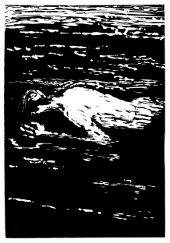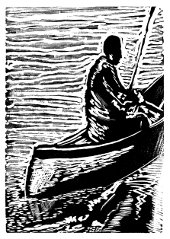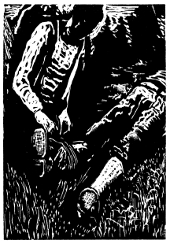The Porcupine's Quill
Celebrating forty years on the Main Street
of Erin Village, Wellington County
Instructor Resources
The Mysterious Death of Tom Thomson:
Study Guide
Return to: Theories Home
Theories & Hypotheses
Theory #1: Accidental Drowning
Goldwin W. Howland was a Toronto physician and professor of neurology at the University of Toronto, vacationing on Little Wapomeo Island, who saw an unidentifiable object in the water off Hayhurst Point on the morning of Monday, July 16 and asked two local guides, George Rowe and Laurie Dickson, who were in a canoe on the water at the time, to investigate. It was Rowe and Dickson who recovered Tom’s body (see page 207 of The Mysterious Death of Tom Thomson).
Dr G.W. Howland, Toronto, July 17, 1917:
‘Body of Tom Thomson, artist, found floating in Canoe Lake, July 16, 1917. Certified to be the person named by Mark Robinson, Park Ranger. Body clothed in grey lumberman’s shirt, khaki trowsers and canvas shoes. Head shows marked swelling of face, decomposition has set in, air issuing from mouth. Head has a bruise over left temple as if produced by falling on rock. Examination of body shows no bruises, body greatly swollen, blisters on limbs, putrefaction setting in on surface. There are no signs of any external force having caused death, and there is no doubt but that death occurred from drowning.’

Dr Howland examined the body the next morning, Tuesday, July 17 because the arrival of the coroner, Arthur Ranney of North Bay, had been delayed. By his sworn deposition (above) Dr Howland would seem to be convinced, in his own mind, that Tom had drowned, but Howland was not acting as a coroner and did not comment, either way, as to whether he thought the ‘drowning ’ was accidental. By the time the coroner did arrive at Canoe Lake (the evening of July 17) Tom’s body had already been buried in Mowat cemetery.
One problem with Dr Howland’s deposition is that one such version specifies a ‘bruise ’, consistent with a fall, as being found over the left temple, and yet another version (supposedly delivered to Tom’s brother, George) talks about a bruise over the right temple. The apparent confusion is odd, though the bruise itself could be consistent with accidental drowning if Tom had perhaps tripped in his canoe, fallen, hit his head on a gunwale, knocked himself unconscious, rolled off the canoe into the water and drowned. Particularly if Tom had been drunk at the time of the accident, except that early afternoon (particularly on a Sunday) sounds a bit unlikely of a time for Tom to have been drunk enough to do himself harm. And this does not sound like the sort of misadventure that would happen to an expert canoeist, which Tom was.
Mark Robinson was the Park Ranger who identified the body at the request of Dr Howland. Mark’s testimony is perhaps more credible than that of others, specifically because part of his job as Park Ranger required him to meet incoming rail traffic at Canoe Lake station, and to familiarize himself with the identities of new arrivals. Mark was looking, in particular, for possible poachers, but he also had a keen sense of the composition of the Canoe Lake community in general. Blodwen Davies was a reporter, originally from Fort William (Thunder Bay), who later moved to Toronto and in 1935 wrote and self-published a biography of Tom Thomson called Paddle and Palette. Martin Blecher and his sister Bessie found Tom’s canoe on the afternoon of July 8th, and towed it to Mowat Lodge (pages 207, 209, 211).
Mark Robinson to Blodwen Davies, 1930:
‘We buried his remains in the little cemetery at Canoe Lake, Martin Blecher Sr. reading the Anglican funeral service at the grave. Later his remains were taken up and went to Owen Sound for burial. Dr Ranney of North Bay conducted what inquest was held. Tom was said to have been drowned. It may be quite true but the mystery remains.’
Dr A.E. Ranney [Coroner], Letter to Blodwen Davies, May 7, 1931:
‘The body was in such a state of decomposition when found that it had to be buried as quickly as possible. The body was thoroughly examined by Dr G.W. Howland, qualified Medical Practitioner of Toronto, before inquest, who gave me a full description of the condition of the body. There was only one bruise on the right side of head, temple region about 4 inches long, this, no doubt, was caused by stricking some abstacle, like a stone, when the body was drowned. Dr Howland swore that death was caused from drowning, also the evidence from the other six witnesses points that the cause of death was drowning. Those who were present at the inquest were as follows: Dr G.W. Howland, Miss Bessie Belcher [Blecher?], Mr J.E. Colson, Prop Algonquin Hotel, Mr J.S. Fraser, Prop Mowat Lodge, Canoe Lake, Mr Mark Robinson, Park Ranger, Mr Martyn Belcher [Blecher?], tourist and Mr G. Rowe, resident guide.’

One problem with the accidental drowning theory is that Tom Thomson was an expert canoeist (see pgs 115, 117, 119 &c); Tom did, however, drink alcohol (p 157, 173) which sometimes led to fights (p 155). Alcohol could have been a contributing factor, which would not have been evident when Dr Howland examined the body on July 17, after it had been in the water over a week.
And then there’s the curious circumstance that the body was found with a length of fishing line wrapped around one ankle, which could, perhaps, support a theory of accidental drowning, unless of course the fishing line was perhaps attached to a weight of some sort, intended to deliberately sink the body, in which case the fishing line supports a theory of manslaughter at least, and possibly murder. There is one other suggestion ... that Tom may have sprained his ankle and had wrapped the ankle himself in fishing line, for support, to relieve the pain. This seems not terribly likely, because it would take a lot of fishing line to tape an ankle.
Thomson biographer David Silcox has suggested a variation on the Accidental Drowning theory in which Tom may have stood up in his canoe to urinate over the side, tripped on his fishing line, fell, hit his head on a gunwale on the way down, knocked himself unconscious, rolled off the canoe into the water and drowned. Except that an experienced canoeist would never stand up in a canoe to urinate, and David Silcox, an accomplished canoeist himself, would know that.
The Fishing Line
The fishing line that was found wrapped around Tom’s right ankle is troublesome.
It is unlikely, as some have suggested, that Tom may have wrapped the line himself to relieve the discomfort of a sprained ankle ... simply because fishing line is thin and it would take a lot of tedious winding to build up sufficient rigidity to support a sprained ankle. If Tom did not wrap the line himself then we do have to consider the possibility that Tom inadvertently got himself tangled in fishing line, but that does not sound like the sort of thing an expert canoeist would allow to happen, and it is also inconsistent with Mark Robinson’s description of the state of the canoe when it was recovered, which made mention of the fact that Tom’s camping gear was neatly stowed and at least one paddle was lashed to the inside of the canoe (as it would be to facilitate a portage) though Robinson also noted that the paddle was secured with a type of knot that Tom Thomson did not favour.
If we suspect that Tom, deliberately or inadvertently, did not wrap the fishing line himself, that leaves the real possibility that someone else (possibly the murderer) may have done the wrapping as part of an attempt to ensure the body, once dumped, stayed sunk in Canoe Lake.

The body was found with a length of fishing line wrapped around one ankle, which could be consistent with death by accidental drowning, though there are other plausible explanations for the fishing line that are equally persuasive.
Typically, in the case of a drowning, the victim’s lungs fill with water which weights the corpse enough to sink it until gases released by decomposition of the flesh generate enough buoyancy to force the body back to the surface. This process can be quite rapid but it is variable and dependent on the temperature of the water. Canoe Lake is not large, but it does include 21 km of shoreline, so it is substantial and the lake is as much as 150 feet deep in places, where the water would be very cold and could partially explain why the body did not surface until a week later.
Or, perhaps the body had surfaced earlier, and no-one noticed it. But that’s not likely because Canoe Lake, at its widest, is still just four hundred yards across to the far shore.
It is also curious that Dr Howland noticed there was no water in Tom’s lungs, even after eight days’ submersion. This condition is not common with victims of drowning though it is not unheard of either and could have been the result of a spasm in the throat that blocked the windpipe. If Tom’s lungs were filled with air, however, then one would have expected the body to surface sooner, unless, of course, the corpse had been weighted with some sort of anchor.
As recently as 1969 the CBC interviewed pathologist Dr Noble Sharpe and asked, amongst other things, if Dr Sharpe could agree that it might have been possible for the submerged body to have entangled itself in fishing line simply by the action of currents in the water. Dr Sharpe agreed that such a scenario was within the realm of possibility though he added that he had no first-hand experience of any such occurence and Dr Sharpe had been, at one time, Ontario’s chief forensic medical investigator.
The fishing line that was wrapped around Tom Thomson’s right ankle was not anything like the monofilament line that followed from DuPont ’s invention of nylon in 1938 and remains in common use today.
We know, for example, that the Chinese used line made of silk for angling as early as the fourth century. We can only assume that people before this may have used vines as line or perhaps fine thread made from plant fibre. We know from the journals of Samuel Pepys that the fishing line he used in 1667 was made from catgut or silk. Woven horsehair was popular in the early 20th century so it is possible that Thomson may have used horsehair. Silk threads were long and much stronger than horsehair and silk line could be made by machines, which was an advantage because horsehair line had to be made by hand. Silk line had drawbacks though, because it had to be rinsed and dried on open spools after every use and it was vulnerable to damage from ultraviolet light from the sun.
Thomson certainly could have used either silk or horsehair but some have suggested that he may have used copper line.
We do not know, and we will never know, exactly what type of line was wrapped around Thomson’s ankle but line made of braided horsehair wears quickly if used frequently. The individual strands tend to break and fray which weakens the line at that spot and the line would break eventually. For many fishermen silk line replaced horsehair in 1908 because it could be produced mechanically and hence it was cheaper to buy. Thomson could also have used linen thread as fishing line, though linen line was also susceptible to damage from bacteria, mold and ultraviolet light. Linen or silk would likely have rotted if used to hold Thomson’s body under water. This could explain why it rose to the surface a week after his death. Copper line would have proved more resilient as a tether.
Tom’s fishing pole, that might have been attached to one end of the fishing line, was never found.
More Theories & Hypotheses
- Theories Home
- Theory #1: Accidental Drowning
- Theory #2: Manslaughter
- Theory #3: Murder with a Paddle
- Theory #4: Subdural Hematoma
- Theory #5: Murder with a Gun
- Theory #6: Suicide
- Further Mystery: Interment
This Study Guide is available as a free download in Pdf format to anyone interested in using it as an aid to teaching George A. Walker's The Mysterious Death of Tom Thomson (2012). The Guide may not be copied and offered for sale by any third party. This Study Guide is produced with the support of the Ontario Media Development Corporation and the Ontario Ministry of Education.

The Porcupine's Quill would like to acknowledge the support of the Ontario Arts Council and the Canada Council for the Arts for our publishing program. The financial support of the Government of Canada through the Canada Book Fund (CBF) is also gratefully acknowledged.
The Mysterious Death of Tom Thomson:
- Introduction
- Who Is Tom Thomson?
- Visual Literacy
- Source Materials
- Theories & Hypotheses
- Master Class
- Appendix A: Glossary of People & Places
- Appendix B: Chronology of Events
- Download the Study Guide